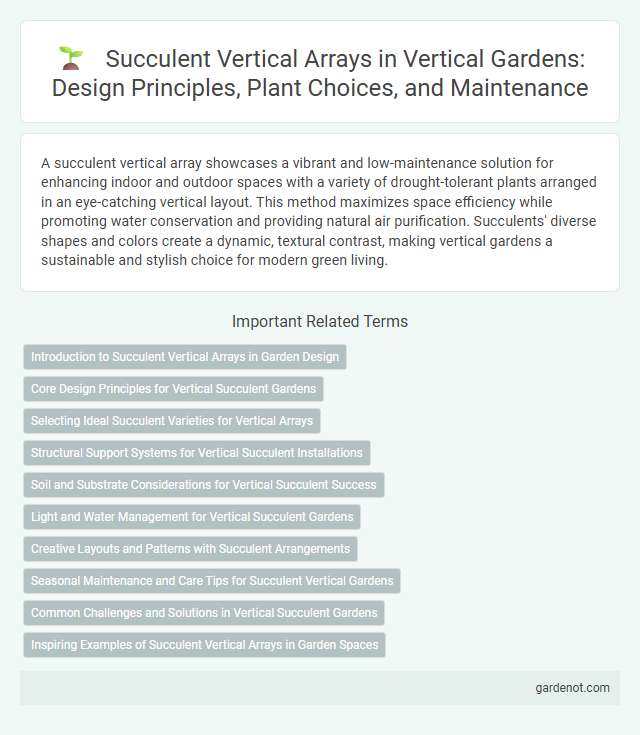A succulent vertical array showcases a vibrant and low-maintenance solution for enhancing indoor and outdoor spaces with a variety of drought-tolerant plants arranged in an eye-catching vertical layout. This method maximizes space efficiency while promoting water conservation and providing natural air purification. Succulents' diverse shapes and colors create a dynamic, textural contrast, making vertical gardens a sustainable and stylish choice for modern green living.
Introduction to Succulent Vertical Arrays in Garden Design
Succulent vertical arrays revolutionize garden design by combining drought-tolerant plants with space-saving structures that enhance aesthetic appeal and improve air quality. These arrangements utilize a variety of succulent species, such as Echeveria, Sedum, and Crassula, known for their hardy nature and vibrant textures, thriving in vertical planters or living walls. Incorporating succulent vertical arrays increases greenery in small urban spaces, reduces water consumption, and creates visually striking focal points that require minimal maintenance.
Core Design Principles for Vertical Succulent Gardens
Succulent vertical arrays thrive by prioritizing proper drainage and lightweight, well-aerated soil to prevent root rot and ensure optimal water retention. Selecting a sturdy frame with sufficient sunlight exposure supports healthy growth and highlights the varied textures and colors of succulents. Incorporating modular planting pockets allows for easy maintenance and versatility, enhancing plant health and visual appeal in vertical succulent garden designs.
Selecting Ideal Succulent Varieties for Vertical Arrays
Choosing ideal succulent varieties for a vertical garden array involves prioritizing species with shallow root systems, such as Echeveria, Sedum, and Crassula, that thrive in limited soil depth. Varieties with contrasting colors and textures enhance visual interest while requiring minimal water, making them perfect for vertical installations. Succulents with compact growth habits and strong drought tolerance ensure longevity and low maintenance in vertical garden designs.
Structural Support Systems for Vertical Succulent Installations
Succulent vertical arrays rely on robust structural support systems such as metal grids, wooden frames, or modular panels designed to bear the weight and accommodate the shallow root systems of succulents. These support structures often incorporate waterproof backings and irrigation channels to maintain optimal moisture levels crucial for succulent health. Proper anchoring and materials resistant to weathering ensure long-term stability and durability in vertical succulent installations.
Soil and Substrate Considerations for Vertical Succulent Success
Choosing the right soil and substrate is crucial for succulent vertical gardens, emphasizing well-draining, lightweight mixes to prevent water retention and root rot. A blend of coarse sand, perlite, and organic compost ensures optimal aeration and moisture control, mimicking the arid environments succulents thrive in. Incorporating a moisture-retentive layer beneath the substrate can balance hydration without compromising drainage, essential for vertical installations.
Light and Water Management for Vertical Succulent Gardens
Succulent vertical arrays require precise light and water management to thrive in limited space. These drought-tolerant plants prefer bright, indirect sunlight and need well-draining soil to prevent root rot. Implementing tailored irrigation systems like drip watering ensures proper moisture without overwatering, promoting healthy growth in vertical succulent gardens.
Creative Layouts and Patterns with Succulent Arrangements
Succulent vertical arrays transform walls into living artworks through innovative layouts and intricate patterns, combining varying colors, textures, and shapes to enhance visual appeal. Creative arrangements feature alternating rows, geometric shapes, and cascading designs that maximize spatial efficiency while promoting healthy growth. Strategic placement highlights succulents' unique forms, creating dynamic, low-maintenance vertical gardens ideal for both indoor and outdoor environments.
Seasonal Maintenance and Care Tips for Succulent Vertical Gardens
Succulent vertical arrays require minimal watering, ideally once every two weeks, to prevent root rot and maintain healthy growth in varying seasons. During colder months, reduce watering frequency and protect the plants from frost by providing insulation or moving the garden indoors if possible. Regularly inspect for pests and remove dead leaves to encourage airflow and reduce disease risk in succulent vertical gardens.
Common Challenges and Solutions in Vertical Succulent Gardens
Succulent vertical gardens often face challenges such as water drainage issues, sunlight inconsistencies, and nutrient deficiencies, which can lead to root rot and uneven growth. Implementing well-draining soil mixes, strategic placement for optimal light exposure, and controlled irrigation systems helps in mitigating these problems. Using modular panels with built-in drainage and incorporating drought-tolerant succulent species enhances the garden's resilience and maintenance efficiency.
Inspiring Examples of Succulent Vertical Arrays in Garden Spaces
Succulent vertical arrays transform garden spaces with their low-maintenance, drought-resistant plants arranged in creative, space-saving designs. Notable examples include living walls featuring a mix of Echeveria, Sedum, and Crassula varieties that add vibrant textures and colors, perfect for urban balconies or small patios. These installations enhance biodiversity and air quality while showcasing sustainability through water-efficient landscaping techniques.
Succulent vertical array Infographic

 gardenot.com
gardenot.com